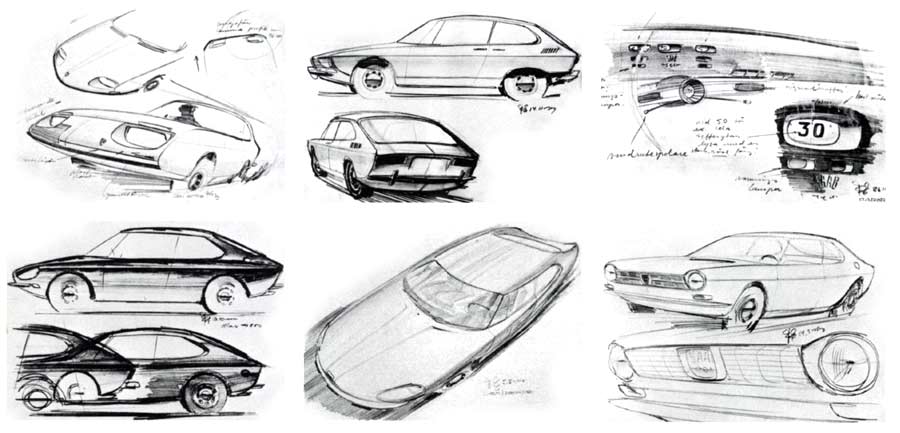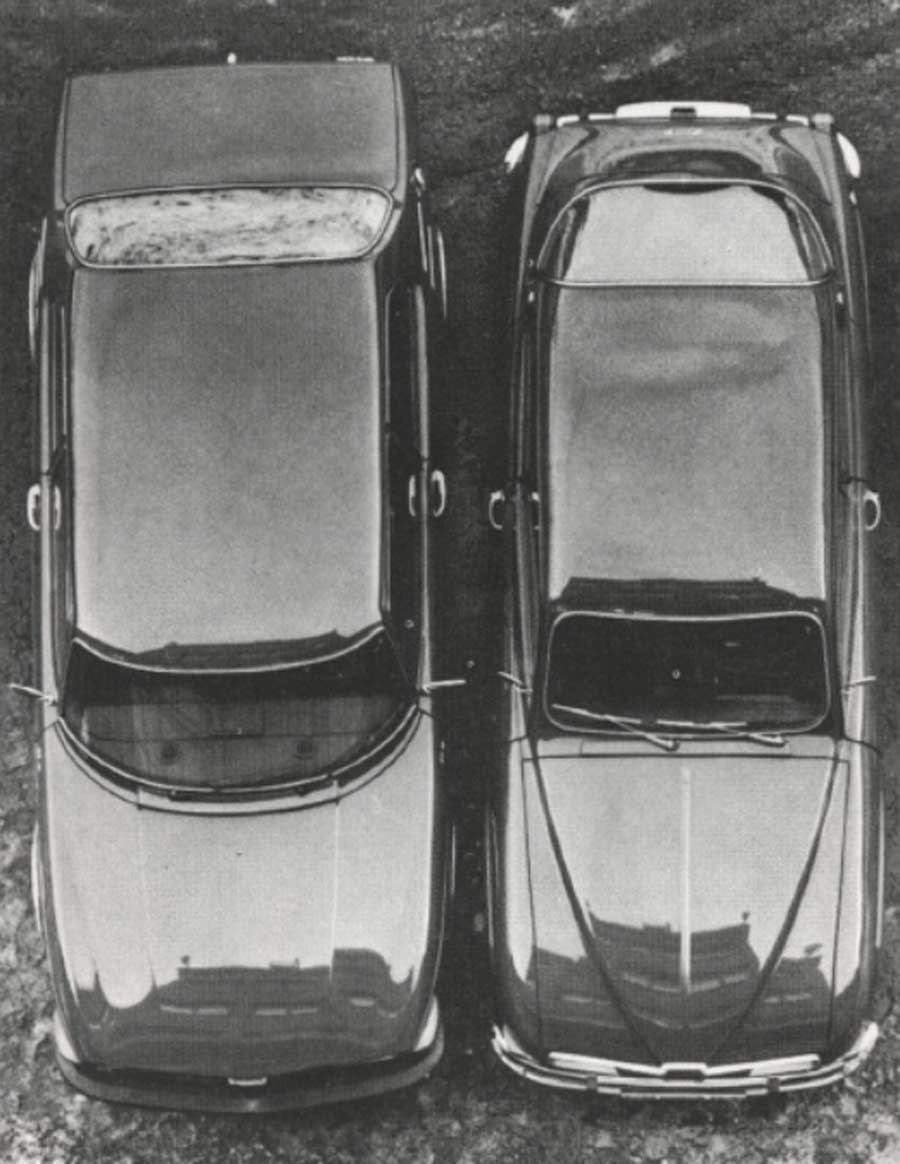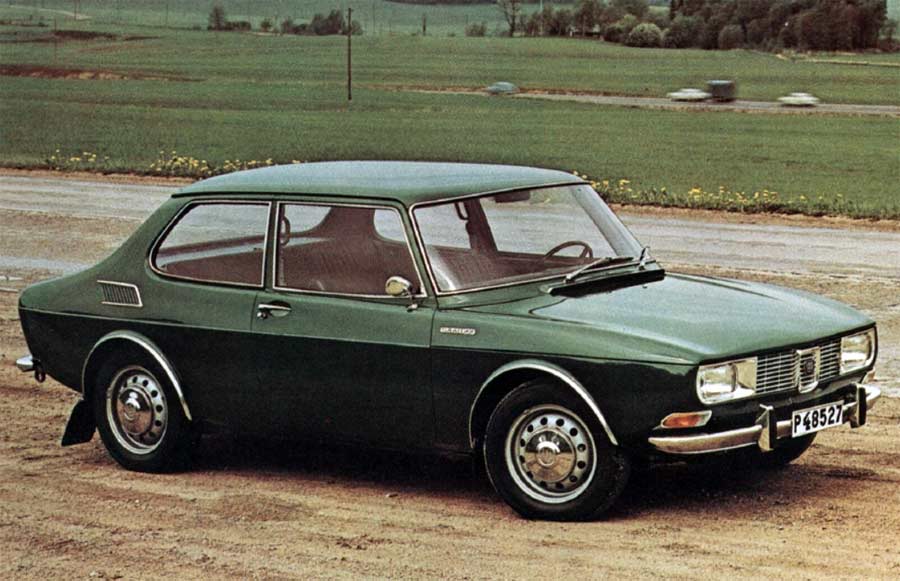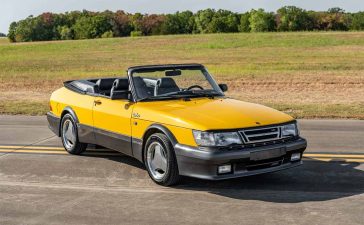Already in the early fifties, just after Project 92 successfully had got into production, Saab engineers began discussing a successor. As can be seen from Sixten Sason‘s many sketches of this period, several ideas were tried. They ranged from city-cars to stationwagons, but finally around 1962 it was decided to make the new Saab model an ordinary family saloon.
Table of Contents
After Project 92
It is interesting to notice that Sason, apart from some freak ideas influenced by the then current Detroit style, had the wedge concept (Iow front, high rear) in mind from the start. Never one for pretty show off styling presentations, many of Sasons sketches are essentially, almost unprofessionably drawn, but they show some very advanced ideas for their time.

When first shown to the public in 1967, the Saab 99 was still a forerunner of the present low nose, high back fashion. But his design was practically finished by 1958. At this time Sixten Sason was running his own independent industrial design firm, being a consultant to Electrolux, Husqvarna and other well known Swedish firms as well as to Saab. His stamp of “function before form” has been put on some very familiar household appliances such as vacuum cleaners and sewing machines as well as on buses and trains.
Preliminary Stages od Saab 99 Design
In 1960, when design of the 99 was in its preliminary stages, a young man of 18, Bjorn Envall was hired as an assistant to Sason. After that he was leader of Saab Design Center – Envall came to play an important part in the 99 evolution – particularly in the final stages, when Sason due to ill health had to exert less effort.
For a small factory like Saab a new model is a bold venture – a failure would in all probability have wrecked the company. To earn back the development costs the car has to be in production for many years, it has still to win customers after competitors have introduced second or third generation models. For most management, this would cause real nightmares the most

Design changes over several years
On these pictures, some shetches of particular significance in the Saab 99 styling evolution. A comparison between the first drawing (1954) and the double-sized side view (1959), both by Sixten Sason, evidences just how much his taste had evolved during those five years, freeing itself from the styling vogue of the time and, also, how the form features of the 99 – e.g. the wedge-like profile of body sides and the markedly curved windshield – were already clear-cut at the end of the ’50s.

All the other drawings of later dates signed by Bjorn Envall, are mainly related to the front and rear end styling characterization process that ended in 1963. Dated the same year is a design exercise called, “Canard” (bottom left layout) to which some of these sketches refer and which affected the aesthetic evolution of the Saab 99.
5 prototypes
The sketched styling proposals on previous pictures found their three dimensional realization in the five small-scale models shown here.

The first from the left anticipates the final body shape shown in two stages of its full-scale development. From 1965 to ’68 road tests continued with camouflaged prototypes until November 1967, when the Saab 99 was unveiled to the public. Before production release the grille was modified to incorporate rectangular headlamps and point out the center badge (in color, an early production Saab 99 and its interior).
Comparison of Saab 96 and Saab 99
In spite of the 20-year gap, the formal evolution from the Saab 96 to the 99 is consistent and compatible with Saab’s visual image, as the overhead view showing dimension comparison and family look proves.

Saab takes a different approach: the only justification for a small factory is to make a distinctive. and in certain respects superior, product to those made by the mass manufacturers. Much of the design philosophy of the originol 92 can be recognized in the 99. There is the same strong accent on aerodynamics, but this time kept within bounds to permit better visibility and generous interior dimensions. All in all the Saab 99 is a good example of industrial design at its best.
An unusually wide track in relation to wheelbase and a high roof line in combination with space saving front wheel drive, has given it accommodation that compares favourably with many bigger cars. The elbow width of the rear seat is one cm wider than that of the Mercedes 200-series and the knee roominess is equally generous. In spite of these box-like general dimensions, Sason and Envall have managed to give the body graceful lines, that at the same time makes it distinctly personal and soberly ageless.
And even more surprising, have retained almost as good a drag coefficient as that of the super streamlined 92 – 0.37 as for the 0.35 of the 92. Typical of the aerodynamic efficiency of the 99, is also the exceptionally low wind noise and the excellent straight line stability. Detail design of the 99 is equally unorthodox end typical of the “driver’s attitude” of Rolf Mellde and his associates.
Large space inside the passenger car
The driver’s seat has not only generous length adjustment but can also be raised, lowered or tilted to get a perfect position for any size of driver. Instruments and controls are layed out in perfect ergonomic fashion, with ideas gained from aircraft experience.
The rear seat is collapsible in stationwagon fashion, vastly increasing the already generous luggage compartment, should the need arise. There are separate heating ducts to the rear seat and to the rear window defroster controls for these are cleverly placed between the front seats, where they can be reached both by driver and rear passengers.
In the updating of successive versions, Saab has refrained from the customary gimmicks, instead offering valuable extras as standard equipment. Typical are the impact-absorbing bumpers, front seats with integral head restraint, electrically heated driver’s seat, headlight washers and wipers: all at their time world firsts.
Color schemes
In the beginning all Saabs were green, and then a great emphasis is placed on colour schemes with harmonized interior trimming. With very small outward differences from one model year to another, one or two distinctive new colours each year give the status-seeker an opportunity to show that he owns the latest model. The Swedish artist Pierre Olofsson, a noted abstract painter and great friend of Sason has for many years had the job of dreaming up new and exciting colours every season. In his typical bohemian fashion he explains how he evolved one of the colours that became the hit of that season: “You take one part cream, one part cheap brandy and one part green Chartreuse: tastes bloody awful, but man what a marvelous colour“.
New engines for the new Saab 99
The 99 was planned at the same time as a four-stroke replacement was thought necessary for the original Saab model. In this case, with a completely new car, that was to share practically no parts with the previous, it was thought more to the point to design and manufacture an engine of Saab’s own. A two-stroke, of course, was out of the Question, but the Wankel was just about beginning to become of serious interest to most car manufacturers. This alternative was seriously considered and Rolf Mellde, who has now left the company, which was a difficult decision for him he ever had to make during his career with Saab. In the end it was thought that the Wankel possessed too many of the two-stroke disadvantages, that Saab were so familiar with. As in the two-stroke the inlet and outlet are regulated by the piston, with consequent difficulties. in lubrication and sealing.

For once, Saab chose the orthodox approach, in deciding on a normal in-line four cylinder four-stroke reciprocating engine. A choice based on sound economical reasons and the fact that, as all the world uses this type of engine, it is backed by a tremendous amount of experience and know-how. The English engine designer Ricardo was contracted as a consultant in the development of the new Saab engine. As work progressed, it became known that British Leyland was working on a simi lar engine design that could fill Saab’s needs to the full. So instead of embarking on their own engine manufacture. Saab chose to buy their 99 engines from Leyland.
Before this deal was finalized however, Saab insisted on taking part in the development work. In Trollhattan laboratories the British engine was subjected to Rolf Mellde’s extremely severe testing procedures and numerous improvements were incorporated, to the benefit of both Saab and British Leyland who, as has been said by technical director Harry Webster, never had conceived of methods quite such tough. The Saab 99 was first shown to the public in autumn 1967 a full year before series production was started; this unusual procedure was decided upon so that the final road testing of the car could be made on public roads.
Sixtem Sason died few months before this preview. Since its introduction the 99 has been produced in steadily increasing numbers and in several versions – first with the original 1.7 litre British built engine, later with a 1.85 litre that could also have an electronically controlled fuel injection. In 1972 Saab started building their own 2-litre version of this engine in Sweden.











